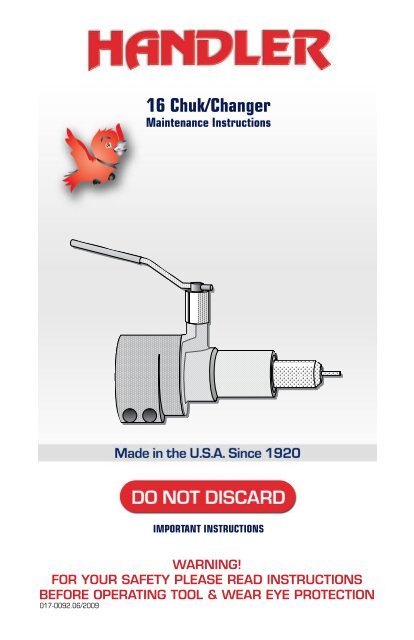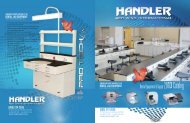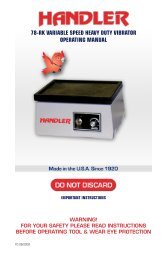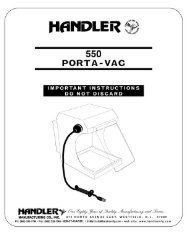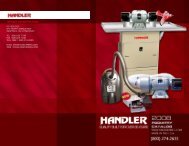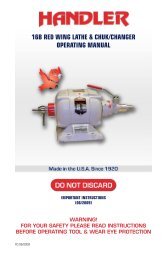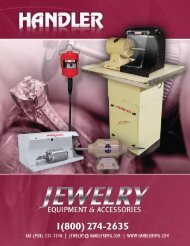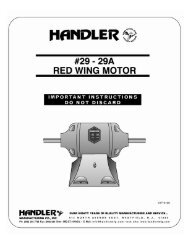16 Chuk/Changer Manual - Handler Manufacturing
16 Chuk/Changer Manual - Handler Manufacturing
16 Chuk/Changer Manual - Handler Manufacturing
You also want an ePaper? Increase the reach of your titles
YUMPU automatically turns print PDFs into web optimized ePapers that Google loves.
<strong>16</strong> <strong>Chuk</strong>/<strong>Changer</strong><br />
Maintenance Instructions<br />
IMPORTANT INSTRUCTIONS<br />
WARNING!<br />
FOR YOUR SAFETY PLEASE READ INSTRUCTIONS<br />
BEFORE OPERATING TOOL & WEAR EYE PROTECTION<br />
017-0092.06/2009
THANK YOU FOR PURCHASING A HANDLER PRODUCT<br />
Thank you for purchasing the HANDLER <strong>Chuk</strong>/<strong>Changer</strong> for<br />
Red Wing and compatible Lathes.<br />
Open the carton and inspect all contents. Your <strong>16</strong> was<br />
inspected several times during the manufacturing process, plus as<br />
a completed unit after it was built and tested.<br />
Should damage have occurred, please contact the freight<br />
forwarder, immediately. Failure to contact the freight forwarder,<br />
immediately, will result in the loss of your rights to place a claim for<br />
possible external or internal damage.<br />
After you have contacted the freight forwarder, please<br />
contact your distributor advising that you have received a unit which<br />
sustained damage, detailing the possible damage and requesting<br />
they contact <strong>Handler</strong>. Possible damage MUST BE CLAIMED by the<br />
receiver of the product, not the sender.<br />
CAUTION!<br />
BEFORE Connecting and Operating!<br />
Unpack Accessories from Unit<br />
For Your Protection EXAMINE THE GOODS.<br />
<strong>16</strong> <strong>Chuk</strong>/<strong>Changer</strong> Instruction
WARNING!<br />
SAFETY INSTRUCTIONS!<br />
WARNING FOR YOUR SAFETY:<br />
READ INSTRUCTIONS BEFORE<br />
OPERATING TOOL.<br />
WEAR EYE PROTECTION!<br />
ALL ELECTRICAL ITEMS WITH A CORD SET:<br />
Repair or Replace Damaged<br />
or worn cord Immediately.<br />
Do not expose to rain or use in<br />
damp locations.<br />
ADVERTISSEMENT:<br />
Ne Pas Exposer a la pluie<br />
et ne pas utiliser dans les<br />
emplacements humides.<br />
<strong>16</strong> <strong>Chuk</strong>/<strong>Changer</strong> Instruction
CHUCK REMOVAL INSTRUCTIONS<br />
CHUCK<br />
REMOVER<br />
PUSH ON AND TAP IN PLACE<br />
TURN MOTOR OFF<br />
PULL HANDLE UPWARD TO REMOVE CHUCK<br />
FIGURE 1<br />
Remove the lathe from the carton and place it in a suitable location on a sturdy horizontal surface.<br />
The unit must be bolted to the table top. Bolting the unit securely to a solid table top will prevent<br />
possible lathe movement during operation and possible operator injury.<br />
Plug the lathe’s cord set into a grounded 115 Volt/60 Hz electrical socket only. Do not utilize a<br />
3-2 prong adapter. Failure to plug the lathe into a properly grounded receptacle may result in<br />
operator injury. Your lathe is now ready for operation with the aid of chucks placed on the shaft (see<br />
instructions).<br />
The No. 26, 26A, 26L, and 28H lathes are constructed to function on two speeds. Low speed is<br />
1725 RPM and high speed is 3450 RPM. The lathe shaft is provided with special dental tapered<br />
shafts which will accept chucks which fit onto a tapered shaft only. The models 27, 29, & 29A are<br />
built to function at 3450 RPM. NOTE: if you have specified that your lathe should contain 1/2” straight<br />
shafts, only chucks which contain a 1/2” arbor hole will adapt to these shafts.<br />
The polishing motor with a tapered shaft is provided with a left and right chuck remover (see figure<br />
No. 1). By pulling upward toward the front of the lathe, the chuck remover will unscrew outward to<br />
“push” the chuck from the tapered shaft. Various types of chucks and chuck accessories are utilized to<br />
perform different types of grinding and polishing operations with your lathe. These are attached to your<br />
lathe’s shaft via a friction fit.<br />
To place a chuck onto the shaft of your lathe, please follow these instructions:<br />
1. Make certain both the lathe’s shaft and the arbor hole of the chuck to be placed onto the shaft are<br />
clean of any dust and debris. Be certain the chuck remover on each side is in place.<br />
2. With the lathe turned “OFF”, place the chuck onto the right or left shaft of your lathe. DO NOT<br />
place a chuck labeled “R” or “L” on the opposite shaft. (See Instructions on following page.)<br />
3. Push the chuck onto the shaft as far as it will go. Since the chucks fit onto tapered shafts via<br />
friction fit, make certain the chuck is placed securely on the lathe shaft. It may be necessary to<br />
tap the end of the chuck onto the lathe shaft with the aid of a soft rubber, plastic or leather<br />
mallet. Do not use a metal hammer or mallet as this will damage the chuck.<br />
4. After the chuck has been placed securely on the lathe shaft, place the buff, brush, abrasive<br />
wheel, bur or mandrel onto the chuck. Secure this in place as per the manufacturers suggestions.<br />
5. Turn the lathe on and make certain the accessory which has been placed on the lathe chuck is<br />
securely in position. If either the chuck or accessory have not been secured to the lathe shaft,<br />
secure it now.<br />
NOTE: Many Red Wing polishing motors are shipped with 1/2” straight shafts. Chucks used on Red<br />
Wing Polishing motors equipped with a 1/2” straight shaft utilize a set screw to hold the chuck in<br />
position. Make certain to tighten this securely.<br />
<strong>16</strong> <strong>Chuk</strong>/<strong>Changer</strong> Instruction
REMOVE CHUCK REMOVER<br />
CHUK/CHANGER INSTALLATION<br />
Fig. 1 Fig. 2 Fig. 3<br />
1/32” maximum allowable shaft<br />
movement (end play) when<br />
approximately 50 lbs pressure<br />
is applied to end of shaft<br />
Pressure<br />
applied here<br />
Scrape off all red paint that is on<br />
the 2” diameter housing.<br />
1/2” shaft<br />
Lathe<br />
Hub<br />
If end play<br />
exceeds 1/6”<br />
condition must<br />
be corrected.<br />
File flat for<br />
set screw<br />
Remove -if hub has plastic<br />
1. Remove the chuck remover<br />
completely from the right side<br />
(or for the left handed <strong>Chuk</strong>/<br />
<strong>Changer</strong>) of the lathe<br />
(See Fig. 1).<br />
If you have a lathe manufactured<br />
prior to 1972, remove the<br />
set screw holding the chuck<br />
remover located on the rear at<br />
the lathes red hub. Remove the<br />
chuck remover completely.<br />
2. Remove the red polymer<br />
cap from the motor hub. Sand<br />
and/or scrap all paint from 2”<br />
diameter lathe hub using the<br />
emery cloth provided.<br />
(See Fig. 3)<br />
3. Using emery cloth, remove<br />
burs, rust or paint from the<br />
1/2” portion of the motor shaft.<br />
4. Place clutch on to 1/2” portion of the<br />
shaft, sliding clutch onto 1/2” portion to<br />
shoulder inside 2” hub. The large diameter<br />
of the aluminum portion of the clutch<br />
should be positioned approximately 1/6”<br />
from the 2” hub. (See Fig. 4)<br />
5. Tighten set screw to mark the shaft<br />
slightly. Loosen set screw and remove<br />
clutch. File a small flat section where clutch<br />
screw secures to 1/2” position of the shaft.<br />
Lightly sand filed portion to remove the bur,<br />
caused by filing. Replace clutch tightening<br />
set screw securely.<br />
Fig. 4 Fig. 5 Fig. 6<br />
1. Use small washers if necessary<br />
to maintain clearance between<br />
clutch hub and lathe housing.<br />
2. Line up set screw<br />
with flat on 1/2” shaft<br />
and tighten securely.<br />
1/<strong>16</strong>”<br />
2-1/2”<br />
Slide <strong>Chuk</strong>/<strong>Changer</strong> with<br />
adapter onto motor hub<br />
and secure in place with<br />
set screws on adapter.<br />
Normal running position will<br />
vary according to amount of<br />
lathe end play.<br />
Never move handle to<br />
running position WITHOUT<br />
a tool in the collet.<br />
6. With <strong>Chuk</strong>/<strong>Changer</strong> handle<br />
in 6 o’clock position, place<br />
<strong>Chuk</strong>/<strong>Changer</strong> with hub<br />
adapter on to lathe hub.<br />
A slight pressure may be<br />
necessary to accomplish this<br />
procedure. Tighten set screw<br />
in <strong>Chuk</strong>/<strong>Changer</strong>’s hub adapter,<br />
evenly<br />
7. Slowly rotate chuck handle<br />
clockwise, to 9:30 o’clock<br />
position. Allow handle to<br />
ease into position. Should the<br />
handle stop beyond the 10:30<br />
o’clock position, the chuck has<br />
not been “slid” on to the hub<br />
properly. (Place the handle<br />
in the 6 o’clock position and<br />
repeat Step 6 above, pushing<br />
the entire assembly towards<br />
the lathe.<br />
NOTE: Should the clutch handle stop before the 9:30 o’clock<br />
position, the adapter set screws should be loosened and the<br />
entire chuck assembly pulled away from the the lathe.<br />
8. Having adjusted the clutch handle into the<br />
proper position, secure all set screws on the<br />
adapter.<br />
9. The operating range of the clutch handle is<br />
6:00 o’clock counter-clockwise to OPEN the<br />
collets and 9:30-10:30 o’clock to CLOSE collets.<br />
MAKE CERTAIN never to close the collets<br />
without a tool in it.<br />
10. Clean collets every 30 days. Lubricating<br />
outside of collets with a LIGHT coat of silicone<br />
grease-ONLY. Always keep a tool in the collets<br />
so the hardened collets will not take a smaller<br />
diameter set.<br />
QUESTIONS Review FAQ section on our website at:<br />
www.handlermfg.com or call 1-908-233-7796.<br />
<strong>16</strong> <strong>Chuk</strong>/<strong>Changer</strong> Instruction
PARTS AND ACCESSORIES<br />
PARTS LIST:<br />
Below is a list of parts and accessories for the RED WING and most other Bench Lathes.<br />
No.1 Special collet for burrs and all 3/32” tools<br />
No.1A A 3/32” burr adapter<br />
No.1B A 1/8” burr adapter<br />
No.1C A 3mm burr adapter<br />
No.2 Pop-out spring<br />
No.3 Stop (state length)<br />
.265, .275, .285, .295, .305, .315<br />
No.3S Set of 6 stops (one of each length)<br />
(use shortest stop possible that will still<br />
allow the tools to slip into the master collet)<br />
(the life of a worn collet may be extended by<br />
using a shorter stop)<br />
No.4 Stop lock screw<br />
No.5 Master collet - should be cleaned and lightly<br />
greased every 60 days<br />
No.6 Special collet, complete with pop-out spring<br />
and .275 stop<br />
No.7 Clutch spring (Note: If <strong>Chuk</strong>/<strong>Changer</strong> Wells<br />
Type is used on left side, please state for left<br />
side)<br />
No.8 Collet wrench<br />
No.9H Handle with plastic cushion grip<br />
No.9HS Safety strap<br />
No.10RW Clutch complete for all Red Wing lathes<br />
No.10B Clutch complete for all Baldor lathes<br />
No.10RM Clutch complete with bearing for all<br />
Robbins-Myers lathes<br />
No.10R Clutch complete with bearing<br />
for all Ritter lathes<br />
No.ADRW Adapter for all Red Wing Lathes<br />
No.ADB300 Adapter for all Baldor lathes<br />
No.ADB221 Adapter for all Baldor 221-240 series<br />
lathes<br />
No.ADB210 Adapter for all Baldor 210-211<br />
series lathes<br />
No.ADRM Adapter for all Robbins-Myers lathes<br />
No.ADRC Adapter for all Ritter C lathes<br />
No.ADRC Adapter for all Ritter C lathes<br />
No.ADRA Adapter for all Ritter A lathes<br />
No.11 Clutch lining<br />
No.12 Clutch lining screws (set of 3)<br />
No.13 3/32” Hex wrench<br />
No.14 Sandpaper chuck<br />
No.15 Arbor band chuck 3/4” diameter<br />
No.<strong>16</strong> Sprial chuck<br />
No.17 Field sandpaper chuck<br />
No.18 Arbor for burrs<br />
No.19 Stone chuck for tooth and knife stones, etc<br />
No.20 Stainless steel mandrels with 1-64 screw<br />
for heatless wheels etc<br />
No.20S Screw only, 1-64 screw for No.20<br />
No.21H Stainless steel mandrels with 2/64 screw<br />
for 1-1/2” cutoff wheels<br />
No.21HS Screw only, 2-64 for No. 21H<br />
No.22 Bearings<br />
<strong>16</strong> <strong>Chuk</strong>/<strong>Changer</strong> Instruction
IMPORTANT NOTICE<br />
Adjusting <strong>Chuk</strong>/<strong>Changer</strong> to Tension Collets<br />
The alignment of the <strong>Chuk</strong>/<strong>Changer</strong> to the clutch will alleviate slipping clutch noise problems<br />
and tension collets. Please follow the instructions, below, to alleviate these problems.<br />
1. Remove the plug which connects the lathe from the electrical source.<br />
2. Move the activating handle on the <strong>Chuk</strong>/<strong>Changer</strong> to the six o’clock (open collet)<br />
position as seen in diagram 1.<br />
3. Loosen the top set screw and the two lower set screws, which are found on the<br />
2-1/2” adapter, which hold the <strong>Chuk</strong>/<strong>Changer</strong> onto the lathe.<br />
4. Place your left hand on the left hand side of the lathe and your right hand on the<br />
nose section of the <strong>Chuk</strong>/<strong>Changer</strong>, and push the <strong>Chuk</strong>/<strong>Changer</strong> in toward the lathe<br />
as far as it will go. It will move approximately 1/32-1/<strong>16</strong> of an inch inward toward<br />
the lathe.<br />
5. Holding the <strong>Chuk</strong>/<strong>Changer</strong> in your right hand, move the activating handle clockwise<br />
to the 9:30- 10:00 o’clock position. The <strong>Chuk</strong>/<strong>Changer</strong> will move outward, slightly.<br />
Tighten the three set screws on the adapter which were previously loosened, holding<br />
the <strong>Chuk</strong>/<strong>Changer</strong> in position as seen in diagram 2.<br />
NOTE: If you have another person available to assist you in this short procedure,<br />
ask them to tighten the set screws. If you do not, make certain that you hold the <strong>Chuk</strong>/<br />
<strong>Changer</strong> inward toward the lathe when you tighten the set screws on the adapter.<br />
This should alleviate the squeaking-grinding noise you are hearing by the lathe <strong>Chuk</strong>/<br />
<strong>Changer</strong> combination and place proper tension on collets.<br />
REMEMBER: Clean collets every 30 days.<br />
Your <strong>Chuk</strong>/<strong>Changer</strong> has been manufactured, assembled, adjusted and tested with the<br />
utmost of care to insure that you will receive it in perfect condition. We ask that you<br />
carefully read and follow these step by step instructions.<br />
<strong>16</strong> <strong>Chuk</strong>/<strong>Changer</strong> Instruction
INSTALLATION & MAINTENANCE<br />
CLUTCH SPRING ADJUSTMENT<br />
Loosen the set screw on the spring housing. Hold the<br />
handle in running position 9:15-10:30 o’clock. Rotate<br />
spring housing counter-clockwise about 3/4 of a turn or<br />
until set screw is facing approximately 11:00 o’clock<br />
position. Tighten set screw securely. See insert diagram<br />
for correct spring housing set screw position.<br />
REPLACING CLUTCH SPRING<br />
The clutch spring may be damaged if the handle is forced<br />
beyond limits. See diagram at right. <strong>Chuk</strong>/<strong>Changer</strong> should<br />
be installed on lathe while clutch spring is being replaced.<br />
Remove <strong>Chuk</strong>/<strong>Changer</strong> handle by loosening handle set<br />
screw. (Note: Mark side of cam shaft from which handle is<br />
removed in order to facilitate proper replacement. Loosen<br />
the set screw on the spirng housing. Remove spring<br />
housing. Discard damaged spring. Insert new spring short<br />
end first into small hole in spring housing. Replace spring<br />
housing. Care should be taken to be sure long end of spring<br />
enters small hole in chuck housing. Replace handle and<br />
follow the adjustment procedure under Clutch Spring Adjustment.<br />
REMOVE CHUCK FROM LATHE<br />
Always move handle straight down (6:00 o’clock) and leave it in this position if you have<br />
any reason to remove the chuck from the lathe. If handle is moved, the clutch spring<br />
(Part No. 7) may be damaged or clutch spring tension may be released. When clutch<br />
spring is damaged or tension released clutch will not engage properly. See instructions<br />
under Clutch Spring Adjustment and replacing clutch spring. Normally it is not necessary<br />
to remove the adapter or clutch from the lathe when you return the chuck to the factory<br />
for repair. If it is necessary to remove adapter or clutch refer to the installation instructions<br />
for your particular model lathe. Serious damage to clutch or adapter will result if<br />
instructions are not followed.<br />
OVERHEATING<br />
A new or rebuilt <strong>Chuk</strong>/<strong>Changer</strong> will normally run quite warm (very uncomfortable to the<br />
touch) during the break in period. The break in period will usually last several weeks<br />
depending upon speed and amount of use. Worn collects, collets not screwed in all the<br />
way or too long a stop (Part No.3) will cause overheating, especially in the front portion<br />
of the <strong>Chuk</strong>/<strong>Changer</strong>.<br />
SQUEAKING CLUTCHES<br />
After several months of service, a clutch may glaze and develop a squeak. The squeak is<br />
usually most noticeable as the lathe is coasting to a stop. Remove chuck from lathe (see<br />
instructions under removing chuck from lathe) and lightly sand both fiber and steel clutch<br />
surfaces. If squeaking persists and there is a presence of excessive amounts of dust<br />
around the clutch area, the adapter is improperly mounted, causing misalignment of the<br />
clutches. Refer to installation instructions for your model lathe.<br />
<strong>16</strong> <strong>Chuk</strong>/<strong>Changer</strong> Instruction
OPERATION AND CARE INSTRUCTIONS<br />
CAUTION<br />
Do not attempt to operate <strong>Chuk</strong>/<strong>Changer</strong> unless it is properly installed on lathe.<br />
Never oil or use solvents of any kind on <strong>Chuk</strong>/<strong>Changer</strong><br />
Never close collet without a tool (chuck,burr, etc) in the collet. Allow clutch spring to engage clutch.<br />
(Never push up on handle or let handle snap up.)<br />
Do not remove or attempt to defeat the purpose of the safety strap.<br />
OPERATION<br />
Normal running position, handle 9:15 o’clock to 10:30 o’clock.<br />
To disengage clutch, bring handle down to 8:00 o’clock position, counter-clockwise.<br />
To apply brake, bring handle down to approximately 7:00 o’clock position, counter-clockwise.<br />
(Note: Brake position is used for changing arbor bands, buffing wheels, etc.) To open collet, bring<br />
handle straight down to 6:00 o’clock position. Tools (chucks) burrs, etc., may be changed while<br />
handle is in straight down (6:00 o’clock) position.<br />
USE OF 3/32” DIAMETER SHANK TOOLS IN CHUK/CHANGER<br />
1. With handle straight down, insert tool in inner collet to desired depth.<br />
2. Move handle clockwise to approximately 8:00 o’clock position.<br />
Remove hand from tool and allow clutch spring to return handle to running position.<br />
3. Never push up on handle.<br />
USE OF 1/4” DIAMETER SHANK TOOLS IN CHUK/CHANGER<br />
1. With handle straight down, insert chuck shank into outer collet.<br />
Note: The inner collet will be pushed back inside <strong>Chuk</strong>/<strong>Changer</strong><br />
2. While holding tool in collet, move handle clockwise to approximately 8:00 o’clock position.<br />
3. Remove hand from tool and allow clutch spring to return handle to running position.<br />
4. Never push up on handle.<br />
CLEAN COLLETS EVERY 30 DAYS<br />
1. With lathe switch OFF and clutch handle straight down, (collets open) unscrew otuer collet<br />
(part No.5) with collet wrench (Part No.8) Unscrew counter-clockwise.<br />
2. Remove both inner and outer collets<br />
3. Thoroughly clean collet, you may use solvent to clean collets, however, you must remove all<br />
traces of solvent before replacing.<br />
4. Thoroughly clean collet body hole by using pipe cleaner or small cloth on end of instrument.<br />
Do not use any solvents in this hole. Put a thin film of grease on outside of both collets. (This<br />
purpose of this cleaning is to lubricate and prevent rust. Failure to clean and grease will cause<br />
collets to slip and stick.)<br />
5. Replace collets, with collet wrench, scrwing clockwise.<br />
REPLACING WORN COLLETS<br />
When tools (chucks) burrs, etc. begin to slip, collets should be replaced.* When replacing collets,<br />
always use the shortest possible stop. Part No.3, that will still allow the tools to slip into the master<br />
collet. WE recommend that you keep spare collets Part No.1 and<br />
No. 5 and a set of stops, Part No.3S on hand at all times.<br />
HOW TO REMOVE A STUCK COLLET<br />
A collet may get rusty or dirty and stick if it is not cleaned and greased regularly, or it may stick if<br />
collet is closed without a tool in the collet. Open collet by moving handle staright down (collet open).<br />
Put collet wrench in collet and tap lightly on the end of the collet wrench and at the same time<br />
attempt to unscrew the collet. If this does not loosen the collet, with the handle in the same position,<br />
remove the four screws that hold the chuck on the adapter and remove chuck. Caution: be sure not<br />
to move the handle during this procedure. See instructions under removing chuck from lathe. Grasp<br />
the steel clutch plate to keep it from turning while you remove the collet.<br />
*However, make certain collets have been properly cleaned. Dirty collets may also cause chuck slippage.<br />
<strong>16</strong> <strong>Chuk</strong>/<strong>Changer</strong> Instruction
GROUNDING AND TOOL SAFETY<br />
1. GROUNDING INSTRUCTIONS<br />
This tool should be grounded while in use to protect the operator from electric shock.<br />
The tool is equipped with an approved three-conductor cord and three-prong grounding<br />
type plug to fit the proper grounding type receptacle. The green (or green and yellow)<br />
conductor in the cord is the grounding wire. Never connect the green (or green and yellow)<br />
wire to a live terminal. If your unit is for use on less than 150 volts, it has a plug that looks<br />
like that shown in sketch (A) in Figure 1. If it is for use on 150 to 250 volts, it has a plug<br />
that looks like that shown in sketch (B). Use of an extension cords or a 2 prong adapter is<br />
not recommended.<br />
2. TOOL SAFETY INSTRUCTIONS<br />
1. Keep Work Area Clean: Cluttered<br />
areas and benches invite accidents.<br />
2. Avoid Dangerous Equipment<br />
Don’t expose power tools to rain.<br />
Don’t use power tools in damp or wet<br />
locations. Keep work area well lit.<br />
3. Keep Children Away<br />
All visitors should be kept safe distance<br />
from work area and appliance.<br />
4. Store Idle Tools<br />
When not in use, tools should be stored<br />
in dry, high, and locked location out of<br />
the reach of children.<br />
5. Don’t Force Tool<br />
It will do the job better and be safe at<br />
the rate for which it was designed.<br />
6. Use Right Tool<br />
Don’t force small tool or attachment to<br />
do the job of a heavy-duty tool.<br />
7. Wear Proper Apparel<br />
Do not wear loose clothing or jewelry which<br />
may get caught in moving parts. Tie back<br />
long hair or use a proper hair net.<br />
8. Use Safety Glasses<br />
Use safety glasses with all rotating tools.<br />
Also use a face or dust mask if cutting<br />
operation is dusty.<br />
9. Don’t Abuse Cord<br />
Never carry tool by cord or yank it to<br />
disconnect from receptacle. Keep cord<br />
from heat, oil, and sharp edges.<br />
10. Secure Work<br />
Use clamps or a vise to hold work. It’s<br />
safer than using your hand and it frees<br />
both hands to operate tool.<br />
11. Don’t Overreach<br />
Keep proper footing and balance at all<br />
times.<br />
12. Maintain Tools with Care<br />
Keep tools sharp and clean for best and<br />
safest performance. Follow instructions for<br />
lubricating and changing accessories.<br />
13. Disconnect Tools and TURN OFF.<br />
When not in use; before servicing; when<br />
changing accessories such as blades, bits,<br />
cutters, etc.<br />
14. Avoid Accidental Starting this and any other<br />
appliance. Be sure switch is OFF when<br />
plugging in.<br />
<strong>16</strong> <strong>Chuk</strong>/<strong>Changer</strong> Instruction 10
IMPORTANT NOTICE<br />
WHAT SHOULD YOU DO TO RETURN GOODS<br />
1. Our terms of sale are F.O.B. our plant. <strong>Handler</strong> makes every effort to insure the<br />
proper delivery of goods, but we cannot guarantee the carrier’s performance. Each<br />
product is tested and inspected for proper performance prior to leaving our facility.<br />
The responsibility for damage in transit is the carrier’s, whether it is visible damage<br />
or concealed damage.<br />
2. Inspect this shipment IMMEDIATELY. Insist that visible damage or possible damage<br />
be written on the Delivery Receipt by the receiver.<br />
3. Inspect the contents of your shipment within 24 hours of receipt. Using your copy<br />
of our packing list, check for piece count and accuracy immediately to insure proper<br />
billing.<br />
4. If damage is discovered, save all crates, cartons and packaging material until an<br />
inspection has been made by an agent of the carrier.<br />
5. In case of damage, notify the delivering carrier IMMEDIATELY requesting that an<br />
inspection be made. Retain a copy of the inspection request for claim purposes.<br />
Failure to notify the freight carrier immediately will result in the loss of your rights<br />
to claim damage.<br />
6. We have taken every precaution to insure safe arrival of your products. We cannot<br />
be responsible for negligence by another party.<br />
7. The receiver of the goods must make claims for incorrectly shipped goods to the<br />
shipper within 15 days of receipt of delivery.<br />
RETURNING GOODS<br />
1. DO NOT return merchandise without our authorization. You must call first for a return<br />
authorization number.<br />
2. We will not accept returned merchandise from the carrier unless our authorization<br />
NUMBER has been issued, and is clearly marked on the outside of the carton.<br />
3. We will not accept goods (i.e. dust collectors) that are not cleaned and free of dust<br />
and debris. The merchandise will be shipped back. This is in compliance with OSHA<br />
regulations.<br />
HANDLER MFG.<br />
612 NORTH AVENUE EAST, WESTFIELD, NEW JERSEY 07090<br />
<strong>16</strong> <strong>Chuk</strong>/<strong>Changer</strong> Instruction 11
WARRANTY<br />
This HANDLER product is warranted to be free from defects in material and workmanship,<br />
when used under the conditions recommended by the manufacturer, and/or the purpose for<br />
which the product was intended, for a period of 12 months from the date of shipment from<br />
factory to job site of original owner. Products purchased from distributor warehouse stock<br />
are warranted for a period of 18 months from date of shipment from the manufacturer’s<br />
warehouse.<br />
In all cases, the full name and address of the distributor must be supplied, along with the<br />
name of the customer, product name and number, and serial number. A copy of the original<br />
invoice, showing date of purchase must accompany the warranty repair request.<br />
This warranty will apply to equipment installed, operated and maintained in accordance<br />
with HANDLER procedures and recommendations.<br />
During the life of this warranty, HANDLER will repair or replace (At HANDLER’s option)<br />
free of charge. F.O.B. its plant, any defective part or assembly, if such defect occurred in<br />
normal service and was not due to apparent misuse, abuse, or accident.<br />
Any warranty service performed in the field must be authorized by HANDLER MFG.<br />
Unauthorized service voids the warranty and any resulting charge will not be paid by<br />
HANDLER MFG.<br />
HANDLER MFG. makes no other warranties or guarantees, expressed or implied.<br />
The merchantability of the components is expressly excluded. The manufacturer assumes<br />
no liability for indirect or consequential damages.<br />
Detach or copy and mail back to the address below.<br />
-------------------------------------------------------------------------------------------------------------------------<br />
Customer Name:<br />
Address:<br />
City: State: Zip:<br />
Model No.:<br />
Distributor:<br />
Distributor’s Address<br />
Serial No.:<br />
Return to HANDLER<br />
HANDLER MFG.<br />
612 NORTH AVENUE EAST, PO BOX 520<br />
WESTFIELD, NEW JERSEY 07090-0520


